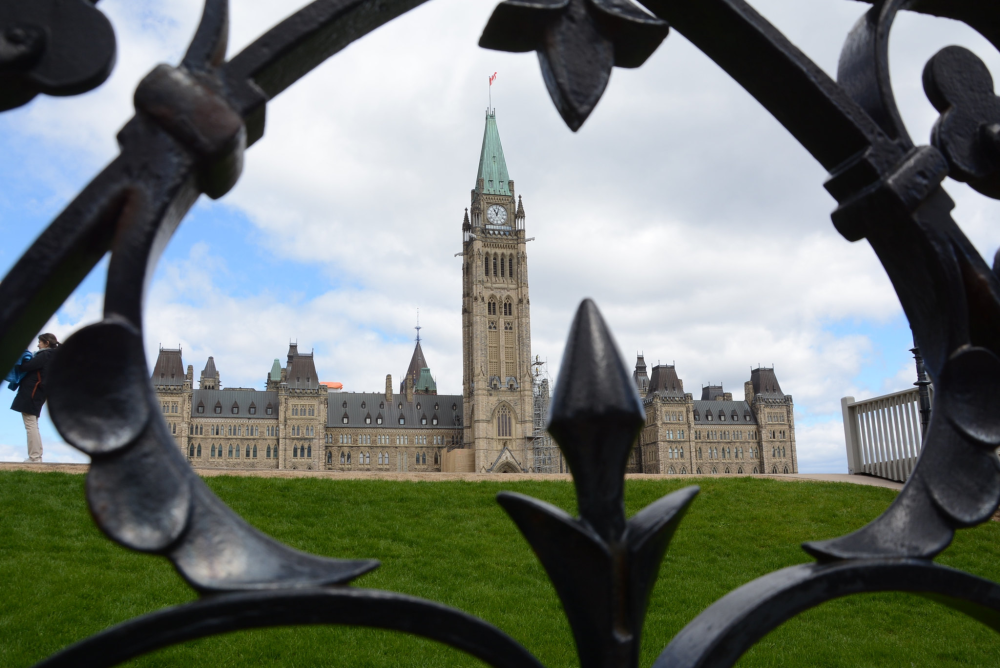With wildfires, flooding, hundreds of heat-related deaths, underwater fossil fuel pipeline ruptures and even the sea on fire, this year has brought us a daily feed of extreme weather events that could have been pulled from a climate change disaster movie. But the climate crisis is all too real, prompting more than 230 medical journals to warn that 1.5 degrees Celsius of global warming above pre-industrial levels risks “catastrophic harm to human health that will be impossible to reverse” and call on governments to respond with “unprecedented funding.” Also this week an international team of scientists published a study concluding that the economic damage from climate change has been vastly underestimated, with cuts to emissions urgently needed to stave off longer-term effects on economic growth.
Given the deadly consequences of climate change, this is no time for half measures and delays. Canada must move forward with the utmost urgency. According to the most recent polls, climate change ranks as a top concern for voters. Every major federal party has released platforms that promise varying degrees of commitment and urgency on climate action. Here are some key must-haves Canadians should be looking for in each of the climate plans.
A shrinking carbon budget
Canada is the tenth-largest emitter globally and the second-highest emitter per capita among G7 nations. Key to driving down overall emissions are rapidly shrinking carbon budgets. A carbon budget sets out how much carbon pollution Canada can put into the atmosphere for a certain period of time. By virtue of being a budget, the understanding is that Canada stays within its limit. A federal climate plan should include a 2030 target (or “bottom line”) that aligns with a commitment to net-zero emissions by 2050, and a carbon budget set to reflect the maximum allowable emissions for a specified period to keep Canada on track to deliver on targets, with the amount of emissions diminishing rapidly over time. In addition to targets and budgets, rigorous policies are required to get there.
Where Canada’s federal parties stand
Conservative Party of Canada: Committed to lower Canada’s emissions by 30 per cent below 2005 levels by 2030; no commitment on carbon budget.
Green Party: Committed to lower Canada’s emissions by 60 per cent below 2005 levels by 2030, to reach net-zero before 2050 as quickly as possible to be net negative in 2050; committed to enacting a detailed carbon budget aligned with Canada’s contribution to limiting global warming to 1.5 degrees Celsius.
Liberal Party of Canada: Committed to maintain Canada’s current emissions reduction commitment at 40-45 per cent below 2005 levels by 2030 and to reach net-zero by 2050; no commitment on carbon budget.
New Democratic Party: Committed to lower Canada’s emissions by 50 per cent below 2005 levels by 2030, reach net-zero by 2050, and establish multi-year national and sectoral carbon budgets.
Plan for global decline in oil and gas demand
Canada’s oil and gas sector produces over 26 per cent of Canada’s GHG emissions, counting only emissions from production, refining and shipping in Canada – not combustion, the source of the vast majority of global emissions from fossil fuels (commonly referred to as Scope 3 emissions). Emissions from this sector have been going up, offsetting reductions elsewhere. At the same time, globally, financial institutions, fossil fuel companies, governments, and authoritative bodies like the International Energy Agency are preparing for a major drop in demand for fossil fuels. As the world moves away from oil and gas and employment and investment decrease, economic diversification strategies are needed to create new jobs and revenue streams. Transition planning and processes should be centred on workers and communities, providing them with a voice on their future, as well as direct support, retraining, and opportunities for historically marginalized communities. Regulations will need to be redesigned to minimize environmental liabilities from the sector, ensuring the cost of clean-up isn’t offloaded onto taxpayers. A federal climate plan should include transition plans for the oil and gas sector based on net-zero pathways and include comprehensive strategies to ensure an equitable and inclusive transition.
Where Canada’s federal parties stand
Conservative Party of Canada: Committed to create a Working Canadian Training Loan that would disperse low-interest individual loans for skills upgrading and to invest $250 million to establish a Canada Job Training Fund, and increase exports of natural gas.
Green Party: Committed to phase out oil and gas operations, with bitumen production phased out between 2030 and 2035, ensure companies pay land clean-up and restoration costs, introduce a Just Transition Act in 2021, and use wage insurance, retraining programs and early retirement plans to replace every high-paying fossil fuel sector job with a high-paying green sector job.
Liberal Party of Canada: Committed to establish a $2 billion Futures (diversification) Fund for oil- and gas-producing provinces, five-year emissions reduction targets for the oil and gas sector to achieve net-zero by 2050, and methane emissions reductions of 75 per cent below 2012 levels by 2030.
New Democratic Party: Committed to create a million new, good jobs for oil and gas sector workers, ensure provincial methane regulations are equivalent with federal regulations and increase methane emissions reduction targets between 2025 and 2030, and force oil companies to cover the cost to clean up inactive wells.
Actions to urgently decarbonize transportation
More than a quarter of Canada’s greenhouse gas emissions come from transportation – a percentage that’s been steadily climbing. Not only are emissions from passenger vehicles rising, emissions from freight transport will soon overtake passenger vehicles. Driving these emissions down requires focusing on the movement of both people and goods. Doing so means boosting the production and availability of zero-emission vehicles (ZEVs) and charging infrastructure across the country. Canadians also need affordable, accessible, low-carbon public transit options, and active transportation infrastructure. For freight, reducing emissions requires smart strategies and investments to decarbonize both long-haul transportation and urban delivery traffic.
Investing in the EV sector can result in job creation throughout the ZEV supply chain, from mining to manufacturing. A federal climate plan should include a 100 per cent by 2035 ZEV sales mandate with incentives for purchase and infrastructure, decarbonization strategies for medium- and heavy-duty vehicles and goods movement, and a commitment to develop and fund public transit and active transportation systems.
Where Canada’s federal parties stand
Conservative Party of Canada: Committed to introduce a passenger vehicle ZEV sales mandate of 30 per cent by 2030, build public transit infrastructure.
Green Party: Committed to ban the sale of all internal combustion engine passenger vehicles by 2030 (which means implementing a passenger vehicles ZEV sales mandate of 100 per cent by 2030), provide grants for the purchase of new and used ZEVs and buy-back programs, exempt new and used ZEVs from federal sales tax; develop a Green Freight Transport program; ensure access to zero-carbon public transit with high-speed rail networks between major cities and investment in light rail and electric bus connections across the country, and expand cycling and walking infrastructure.
Liberal Party of Canada: Previously committed to reaching a target of 100 per cent ZEV sales by 2035 and are now committed to implementing a 50 per cent ZEV sales mandate by 2030; committed to a medium- and heavy-duty ZEV sales mandate (where feasible) of 100 per cent by 2040, invest an additional $1.5 billion in the iZEV rebate program (up to $5,000 per vehicle) and extend eligibility to include used vehicles, and invest $200 million to retrofit large trucks.
New Democratic Party: Committed to new passenger vehicle ZEV sales mandate of 100 per cent by 2035, waive federal sales tax on ZEV purchases and extend federal ZEV purchase incentives to up to $15,000 per family for made-in-Canada vehicles, ensure that federal transit funding prioritizes scaling up low-carbon transit projects like zero-emissions buses and electric trains with the goal of electrifying transit and other municipal fleets by 2030, and promote smart community planning and active transportation.
Climate action compatible with reconciliation
To avoid perpetuating existing inequalities, climate mitigation and adaptation policies must be built on the principles of equity and reconciliation. In particular, planning processes must be inclusive of Indigenous Peoples and historically underrepresented and marginalized communities. One insufficient but important step toward reconciliation is legislating the implementation of the United Nations Declaration on the Rights of Indigenous Peoples (UNDRIP), though the impact of legislation will depend on how it is implemented. Furthermore, explicit representation and consideration of Indigenous Peoples should be built into climate accountability legislation.
Similarly, the impacts of climate change and climate change policies on low-income and marginalized communities should be assessed and addressed in policy design and decision-making frameworks. A federal climate plan, then, should commit to full implementation of UNDRIP, monitoring, publicly reporting on and mitigating the impacts of climate change and related policy on Indigenous Peoples and on their rights, and monitoring and publicly reporting on and mitigating the gendered, socio-economic and racial impacts of climate change and related policy.
Where Canada’s federal parties stand
Conservative Party of Canada: Committed to partial implementation of UNDRIP (specifically Article 18, which states that Indigenous Peoples have the right to participate in decision-making in matters which would affect their rights, through representatives chosen by themselves in accordance with their own procedures, as well as to maintain and develop their own Indigenous decision-making institutions).
Green Party: Committed to implementing UNDRIP for those First Nations who support it.
Liberal Party of Canada: Committed to including a requirement in all ministers’ mandate letters to implement UNDRIP.
New Democratic Party: Committed to implementing UNDRIP.







